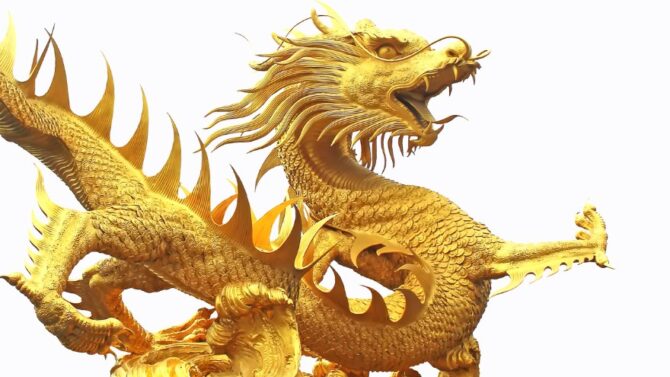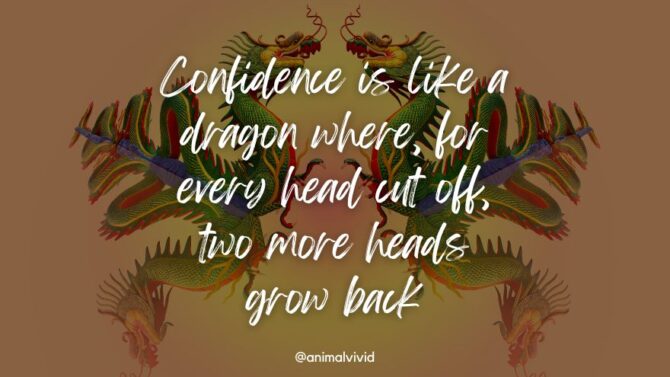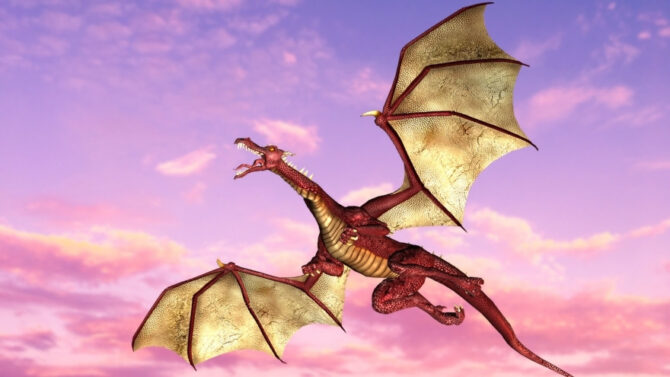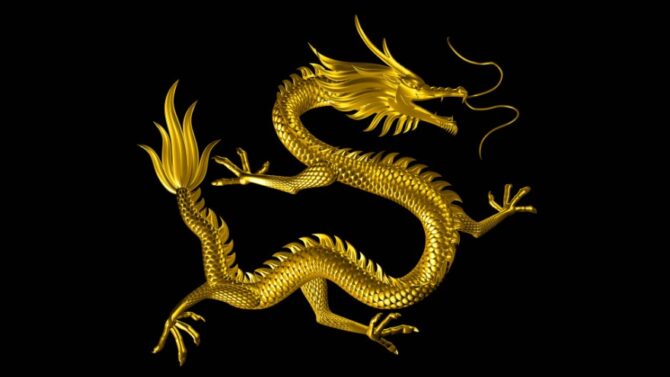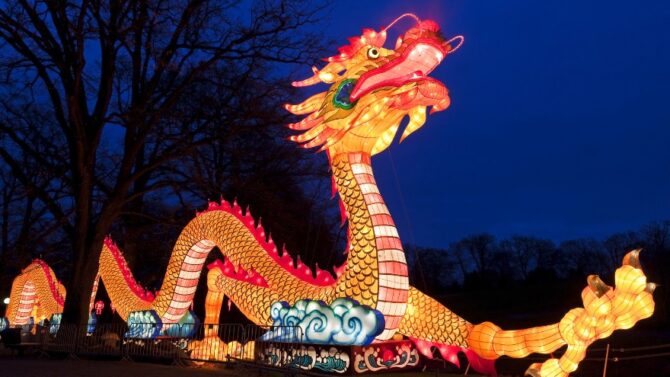Dragons are fantastic creatures that do not exist but yet hold symbolic positions in many cultures.1
Some dragons are believed to hold good luck, while others bring nothing but a mishap.
There are a variety of colors a dragon can possess; not multiple colors at a time, however. The color determines whether a dragon is good, bad, or just neutral.
Dragons exist in so many colors: red, green, black, bronze, gold, etc.
This article aims to reveal different dragon colors and their meanings.
Good Dragon Colors
Gold Dragons
They can survive in any climate, but their habitats are mostly made of stone (cave or castle).
They have a huge preference for precious gems and metals (gold, rubies, diamonds), and they use pearls for nourishment.
Gold dragons obey laws and are very good. They are mostly found defending important objects and artifacts.
One of the abilities they possess is to shapeshift into animals and occasionally humans: they can do this without harm.
Gold dragons mostly roam around in their human forms to make it easier for themselves to explore and discover new things.
They are about 54 feet long and are extremely intelligent, bordering on genius.
Their weapon of attack, aside from their claws and size, is their breath of fire (which contains chlorine).
Silver Dragons
Dragons of this nature often live in caves situated on mountaintops that are extremely close to clouds and similar places.
They can be found in the wind too. It can be said that they enjoy cold climates.
Like their golden counterparts, they can morph themselves into animals and people.
However, they weigh lesser and are a bit shorter. Their vertical length is estimated at 48 feet, and they’re very intelligent too.
Their breath can be either frost or a cloud of paralyzing gas.
Copper Dragons
Their habitat of preference is mostly rocky areas; they prefer living in warm environments.
Copper Dragons are intelligent but tend to be slightly selfish.
Their average length is 36 feet, and they have two breath weapons: a cone of acid or gas that causes lethargy.
Bronze Dragons
Bronze Dragons often live in underground spots located near large bodies of water (oceans, lakes).
Although they enjoy wealth and the benefits attached to it, they are very kind and generous.
They often morph into animals to wander about and check in on the state of human affairs.
These dragons are much larger than brass and copper dragons. Their breath weapons can either be a lightning bolt or a repulsion gas.
Brass Dragons
They are very intelligent creatures and are very much extroverted. Usually found in desert-like areas, they are very much straightforward, albeit selfish.
Although they are quite large in size and long (about 30 feet ), brass dragons are the shortest of all the good dragons.
Their breath can emit dangerous elements that can constitute weapons of destruction: a cone of gas that can cause sleep or induce fear.
Neutral Dragon Colors
Amethyst Dragons
They are the strongest of all the neutral dragons. They tend to live in mountains in northern regions near isolated lakes. Amethyst dragons are chivalrous and majestic.
They tend to live their lives sitting on the fence, not minding the wars being waged between good and evil.
They believe these conflicts are minor in the grand scheme of things, and as long as it doesn’t affect them directly, they will ignore them.
Although amethyst dragons are highly intolerable towards red and white dragons and consider their silver and copper relatives as foolish, they do not inherently have enemies.
Their diet is mostly composed of fish and precious gems.
For the most part, amethyst dragons tend to have hideouts in secluded spots near their habitats.
Their breath can produce a violet lozenge that can go as far as 75 feet.
It is extremely powerful and can gravely hurt animals in its range.
Emerald Dragons
They live in warm climates, specifically in southern tropical waters. They construct their habitats near fully inactive volcanoes.
Emerald dragons are inquisitive and secretive by nature. They can go as far as tracking mercilessly to discover the hideout of each dragon lord and their wards!
Their diet is very much varied; of preference, they consume lizards, giants (or a combination of both if possible). In absence of these, anything will suffice.
Emerald dragons have a long-standing friendship with sapphire dragons, and they fear red and green dragons.
Their breath releases a sound with high frequency that disables the enemy.
Crystal Dragons
This species of dragons are northerners and are very much friendly and open to learning about the world they live in.
They live in extremely cold northern areas and build their lairs using ice and snow.
While they enjoy their own company, crystal dragons are very welcoming to honest people that come towards them.
They do not involve themselves in ongoing fights and would not intervene until it affects them directly.
Although they are sizable dragons, white dragons still consider them as prey.
This causes constant clashes between both species, and often enough, the crystal dragon will use its breath weapon; sharp shards of ice.
Their diet is mainly composed of gems and unrefined metal.
Sapphire Dragons
They are the rulers of underground realms. Although most territories above ground are ruled by emerald dragons, they rule a small portion.
They also control large subterranean caves that can be found under tropical jungles.
They are extremely protective of their territories, and they hardly let anyone new cross their borders. They consume spiders for the most part.
Although they are inherently warriors, they are very much patient when it comes to their enemies.
Sapphire dragons will take their time to study their enemy so that they can discover his weaknesses and create strategies that will make it easy to exploit them accordingly.
When they aim to attack through breathing, they release a high-pitched sound that is barely audible.
Topaz Dragons
They inhabit warm coastal areas and build their homes far from the water line so that it remains fully dry.
They do not like water very much. This said, their diet is mainly fish and other seafood (squid is their favorite), so they have learned how to swim.
Although they are not spiteful by nature, their behavior can be quite erratic and disturbing.
Nevertheless, if a person succeeds in gaining a topaz dragon’s trust and friendship, it is for a lifetime: they are very loyal creatures.
They are quite nonchalant about conflicts concerning dragon kind, and they will only involve themselves when it affects them directly. Their breath weapon is dehydration.
Bad Dragon Colors
Black dragons
The black dragon is often found in muddy areas; on occasion, they can construct their lairs in remote places underground.
This is because they enjoy having their homes in very dark locales.
It is about 30 feet long and is not so intelligent. They can spit acid with their mouth when threatened.
Green Dragons
Like their black counterparts, they enjoy creating subterranean lairs too!
They prefer building their habitats in green areas: dense forests and woods; the wilder, the better.
Green dragons are mean and evil. They are 36 feet long and are averagely intelligent.
Their breath weapon is a poisonous gas that contains substantial quantities of chlorine.
White Dragons
White dragons are northerners and enjoy living in extremely cold climates.
They build their lairs in cold caves or underground; their breath weapon of attack and defense is frost.
They are not as intelligent as other dragons but are as avaricious as other not-so-good dragons.
Red Dragons
The red dragon lives in extremely hilly environments and overly mountainous areas.
They transform small spots they find into caves (mountainside or underground).
With its 48 feet in length attached to its high intelligence, the red dragon is the most powerful of all the bad dragons.
They were named for their breath weapon, which is fire.
Wrap Up
Dragons are mythical creatures that are fun to study.
From their representation to their significance in various cultures due to different colors, these creatures are extremely enlightening.
There are multiple colors a dragon can have, one color per dragon. A dragon of mixed colors is not usually seen or found.
References & Notes
- Dragon – Mythological Creature. Britannica.
